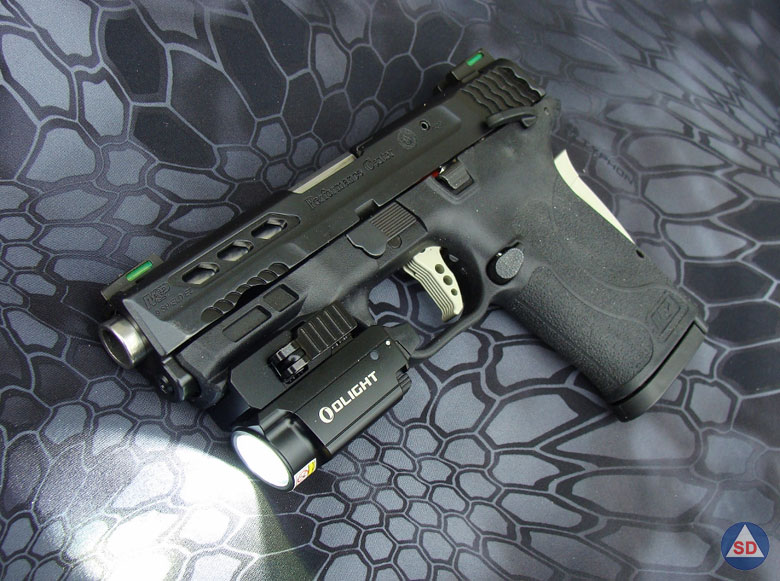
I first covered the S&W 9mm Shield EZ pistol in 2022, during a post about handguns for senior citizens. Due to its unique characteristics, the EZ made the semiauto list, but it was really part of a larger picture.
Now, a year later, that particular pistol has seen more use. Conclusion: It’s worthy of more thorough coverage. Rather than start from scratch, I’ll use the previous post as a foundation. But this one is devoted strictly to the Shield EZ Series. Might as well look at its history while we’re at it.
Debut of the S&W Polymer M&P Pistols
Just before Smith & Wesson’s polymer-framed M&P pistols appeared (during 2005), I was granted an opportunity for a sneak preview. I greeted it with a yawn, but soon thereafter, we (my Agency) had an opportunity to wring out some samples. It turned out those striker-fired pistols did have several desirable qualities to include good ergonomics, enhanced through grip inserts of various sizes.
The timing was fortuitous since our metal-frame double-action S&Ws were aging so, after an extensive T&E session, we wound up purchasing a few hundred duty-sized (4 ¼”) M&Ps. They were an instant hit with our staff, although our plain-clothed folks hoped for a smaller-sized pistol. This was around 2008.
Development of the M&P Shield Series
During 2012, S&W introduced what proved to be a gamechanger for concealed-carry purposes, their micro-sized M&P Shields. These small polymer-framed pistols were quickly brought to our attention so, in short order, more samples arrived in both available calibers; 9mm and .40 S&W. The latter was pretty snappy, but the 9mms we tried (8 +1 versions) were reasonably controllable.
The example I wrung out also proved to be a tack-driver, something I’ve noticed with other short-barreled S&W semiautos dating back to an inventory of D/A Model 3913s. As it turned out, a main drawback to the Shield was the force required to manually operate its slide – a problem for some of our smaller-statured personnel. Still, I liked a 9mm sample so much that I wound up buying it. I’ve since shot the Dickens out of it with nary a bobble, and it’s still in my possession (as is my trusty aluminum-framed M-3913).
Shield EZ Pistol Introduction
The Shield’s stiff slide no doubt put the kibosh on sales among a growing segment of handgun purchasers; women, as well as others concerned about personal security. Fortunately, this situation was rectified through an unusual new “Shield.” Superficially there are some similarities, but the aptly named “EZ” is really a different pistol.
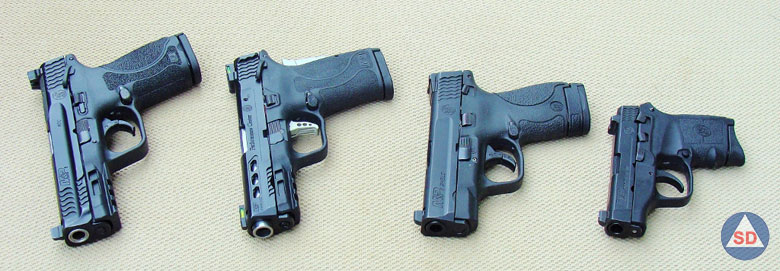
Shield EZ Pistol Details
The EZ first appeared during 2018 as a light-recoiling, compact .380 ACP. Designed for “shootability” and easy operation (EZ), the concept was a big enough hit that a slightly larger 9mm version soon followed. Either model pretty much eliminates strength-related difficulties common to many semiautos. Starting with the operation of its slide, even the 9mm EZ is much more user friendly than my trusty Shield.
Much of this is attributable to the EZ’s internal hammer, a departure from today’s striker-fired systems), that provides “easier” manual slide operation. Also, there’s a set of grasping ears – another effort-reducing feature. The magazine is also well conceived. A set of small protruding tabs permit manual retraction of the follower, eliminating the need for a loading device. The tradeoff is reduced capacity, but the EZ is still an 8 +1 pistol, backed up by rapid reloads.
Safety
S&W put some thought in the safety aspect. Beyond the standard internal drop safety, the EZ incorporates an odd-looking grip-safety similar to that of the well-respected U.S. Model 1911, .45 ACP Government Model. The EZ version is large enough to ensure full disengagement from any normal grip position, but the pistol won’t fire unless it’s depressed.
Interestingly, the initial M-1911 submissions lacked an external safety lever. The Army wanted one so John Browning obliged. You can buy an S&W EZ either way. The EZs will also fire sans a magazine but a tactile loaded chamber indicator is standard.
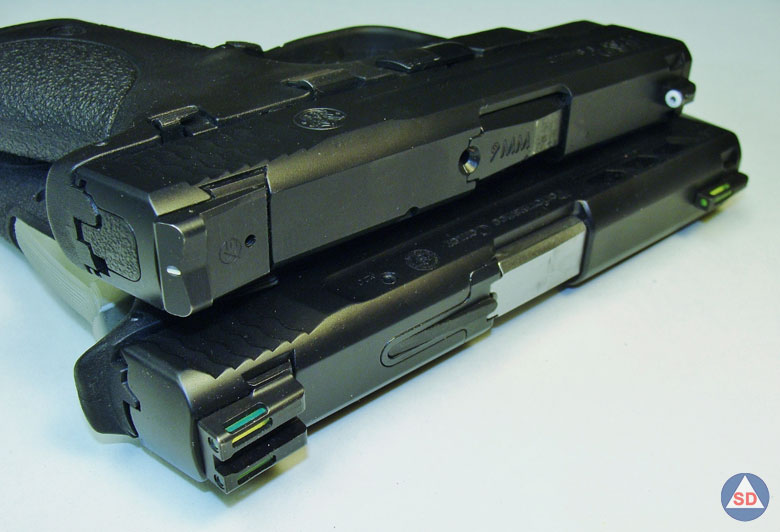
Features
Unlike the full-sized M&Ps, the EZ doesn’t feature interchangeable grips. Still, it manages to strike a nice balance of size and shootability, with a more than acceptable accuracy. Part of this is attributable to its pre-cocked internal hammer. A true “single-action”, this system provides a clean feeling 4 ½-pound trigger pull with a distinct reset.
Also, the EZ’s sight-radius is long enough to provide precise sight alignment (the standard EZs have fixed three-dot sights). The barrel measures 3 ½-inches, long enough that it doesn’t give up much velocity. The EZ’s empty weight is listed as 23.8 ounces. It lacks the ambidextrous slide-stops of a full-size M&P, but the magazine release can be reversed.
The Performance Center EZs
Once the dust settled, S&W launched a series of catchy Performance Center EZs. No longer able to resist, I bought the example pictured here. The foundation is pretty much the same, but it does have a few spiffy features. For starters, the barrel is ported. Advertised to reduce recoil, it extends a bit beyond the face of the slide for an overall length of 3.8-inches. The slide features a series of racy looking ports that mostly just save a bit of weight.
Despite its coolness, I bought this PC model primarily for its fiber-optic/tritium Hi-Viz sights. They’re highly visible in all lighting conditions to include darkness. And, unlike the striker-fired Shields, an accessory rail is standard throughout the EZ line, permitting the easy attachment of a light (or laser).
Being no stranger to a 1911, I opted for an EZ with an active safety. Some consider one an impediment to a defensive response, but I’ve noticed many detractors also own an AR-15 – equipped with a safety lever. If you go this route, unlike a “cocked & locked” 1911, the EZ’s slide can be retracted while on-safe. In contrast to the original Shield, its levers are both generous and bilateral. Rapid access is a non-issue so the key to their effective use boils down to practice – and consistent use of this feature.
Range Report
For accuracy testing, I fired four tried and true favorites off sandbags from 25 yards. Some evaluators test pistols of this size at 15 yards but, as noted above, shorter-barreled S&Ws can print decent groups – often tighter than their full-size relatives. The EZ also has a crisp trigger, and my PC version is fitted with a good set of sights.
Accuracy
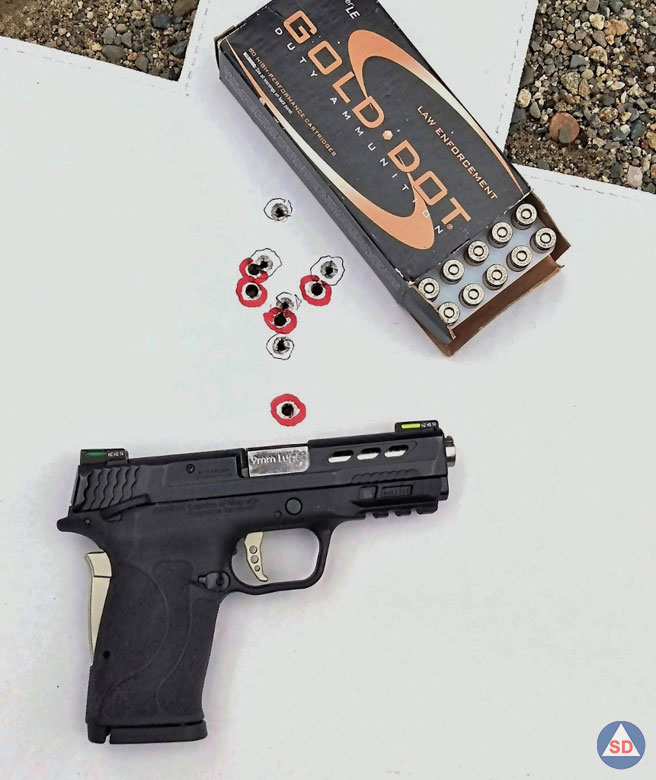
During the initial 2022 test I shot Speer Gold Dot 124-grain JHPs, and Federal American Eagle 124-grain FMJs (see ammo sites for purchase options). Five-shot groups with either load averaged a more than respectable 2 ¼-inches off sandbags.
During 2023, a repeat test of these loads produced identical results. An additional box of Federal’s 124-grain Hydra Shok JHPs did the same – consistently good performance!
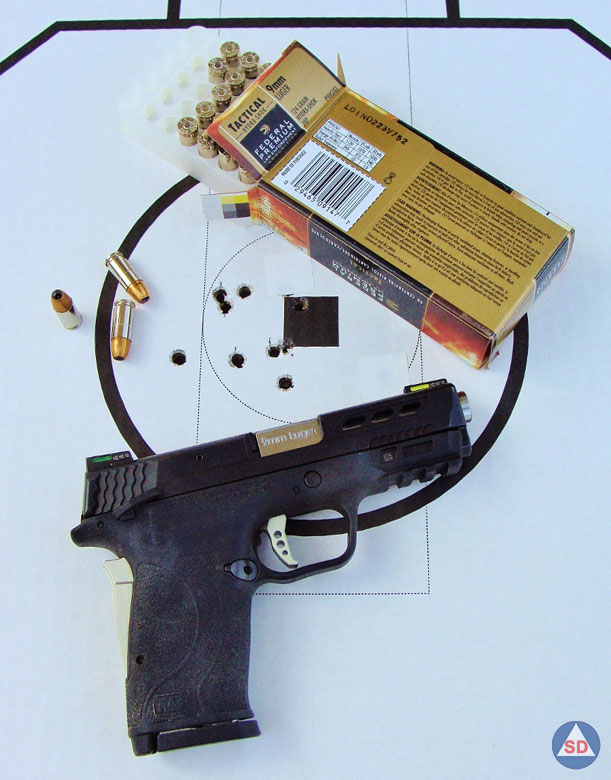
I had high hopes for another longstanding favorite, Speer Lawman 124-grain TMJs, but no such luck. Groups ran an abysmal 4-inches. Two M&Ps on hand that day averaged well under 2-inches from the same box, proving that nothing’s etched in stone (also both are fitted with aftermarket Apex barrels).
Sight Regulation
It’s been my experience that S&W does a good job regulating their fixed sights. Thus, it came as no surprise that my 9mm EZ shot close to its sights at 25 yards with common 124-grain loads. Elevation is fixed, but windage can be tweaked by drifting the rear sight in its dovetail (secured by a setscrew underneath the slide).
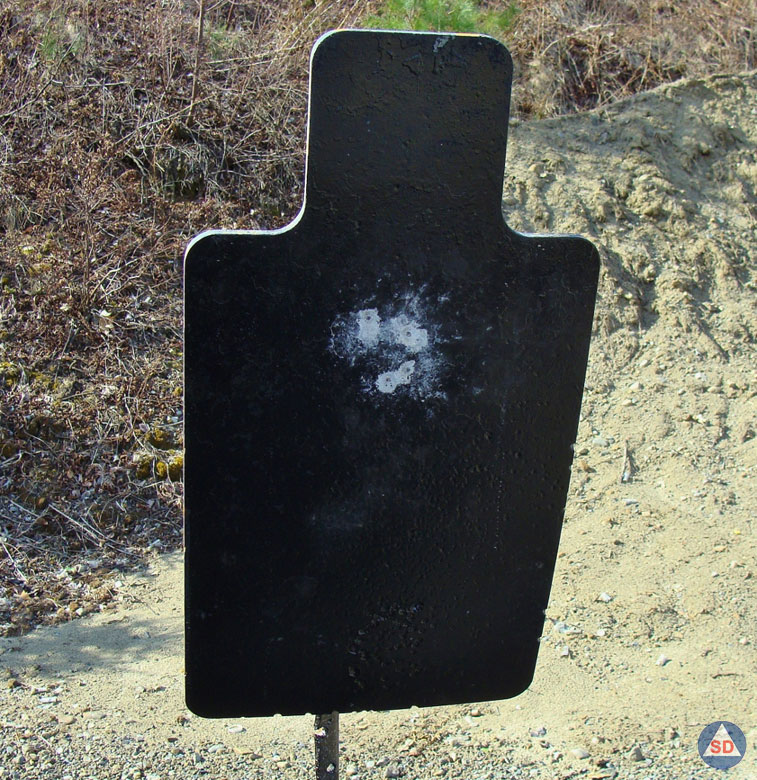
Handling & Control
The EZ was fast and intuitive from the “ready” or a holster. Despite its ported barrel, the above loads did generate some recoil, a consequence of the PC EZ’s 23-ounce weight. Still, it was on par with many other compacts. The textured grip helps maintain control but, if recoil is a concern, Hornady offers a solution through their 100-grain 9mm Lites.
To reduce recoil even more, S&W still sells .380 ACP EZs. They’re slightly lighter versions (18-ounces) of the same pistol in a lighter-kicking caliber. Hornady has an effective .380 load to match this choice, too. I can vouch for its ability to expand, having witnessed the results during FBI testing protocols.
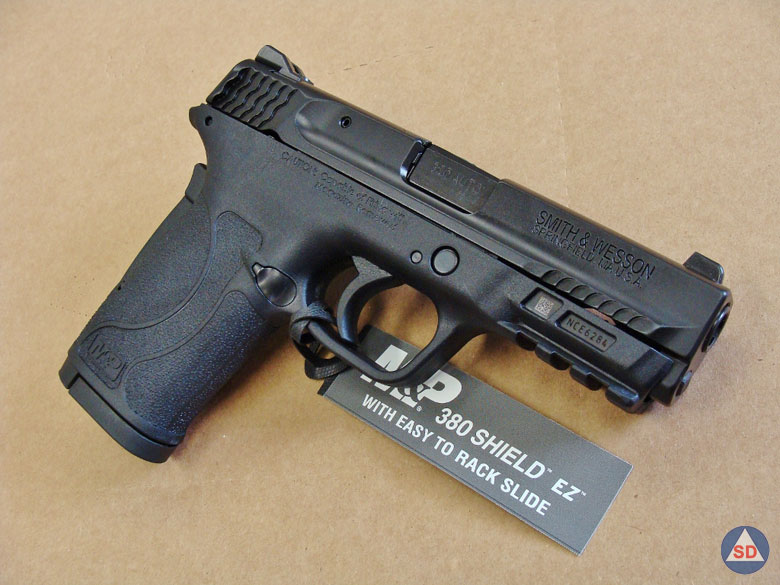
Reliability
No stoppages to report with my 9mm, shooting with either hand and a loose or firm grip. Also, consistent ejection patterns, no deformed cases, and solidly struck primers. I stretched it to 200 rounds between cleanings (bulk ammo sites to purchase your own).
Holsters, Etc.
I started out with a basic Comp-Tac holster, formed from Kydex and it’s worked well enough that I’ve stuck with it, rigged for OWB carry on a durable belt. A spare magazine slides into an open-topped pouch with enough clearance to allow for its protruding finger tabs, something worth checking.
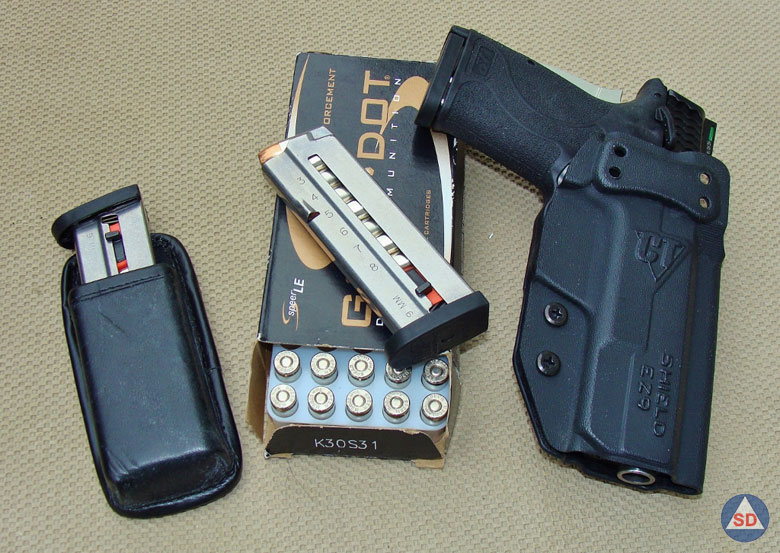
Of course, we need to be sure of our target. At the moment, my EZ is equipped with a small but bright O-light Baldr Mini, which also has a built-in laser. So far so good but, if it quits, I still have the bright set of night-sights for insurance. This system presently serves as a bump-in-the-night handgun largely for this reason (secondary to a 9mm AR). The QD light/laser unit repeats its zero, so I simply detach it when the EZ is carried in its holster.
All-Important Maintenance
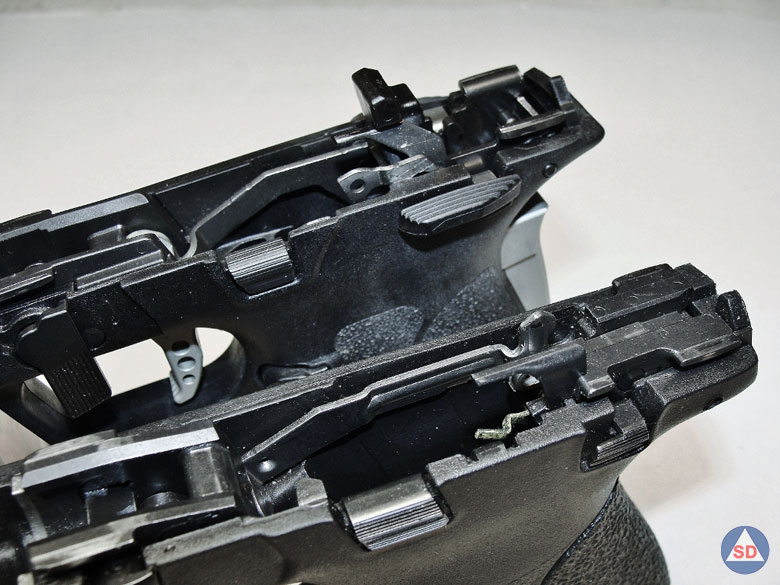
Periodic disassembly is part of the cleaning process but is sometimes skipped with “fiddly” designs. Fortunately, disassembly of the EZ is about as easy as it gets. Flip the disassembly lever and the slide assembly can be drawn off the frame for routine cleaning (the recoil spring is captive on the guide rod).
Unlike many striker-fired designs, the trigger doesn’t need to be pulled. S&W’s M&Ps circumvent this through a sear deactivation tab, but the EZ’s hammer-fired system completely eliminates such concerns. Mine shipped with a useful cleaning kit and clear directions. Follow them and you’ll be good to go – with quality ammunition.

Costs
An 8 +1 pistol might not seem too reassuring nowadays but, unlike some higher-capacity competitors, the EZ’s magazines are easy to top off. Also, its ergonomics shouldn’t be discounted. Despite a comprehensive collection of M&Ps, I find myself reaching for my EZ because it just feels “right”. A basic three-dot sight version retails for $521.
S&W lists the PC versions at $643. My older Shield started out as a basic version, but I wound up investing in a set of aftermarket night sights. The EZ’s sights are mounted in dovetails so similar upgrades are possible, but the PC version is good to go as is. In any case, real-world prices often run lower.
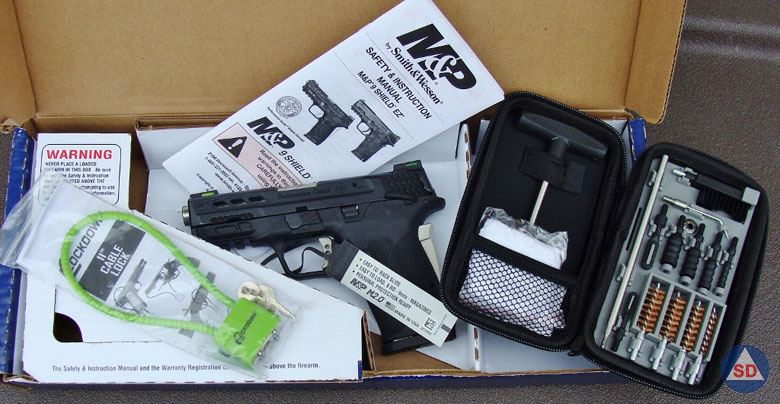
Parting Shots
Still, since “more” is generally deemed advantageous, S&W recently launched a higher-cap version of the EZ, the Equalizer. It weighs the same but boosts capacity. Beyond a flush-fit 10-shot magazine, two extended types boost capacity to 13 +1, and 15 +1. Like most other S&W’s, these pistols are available with or without external safety levers for an MSRP of $599.
Which begs the question: Do you really need an external safety? My older Shield has one, but it’s small and difficult to access. As noted above, like a 1911 Government Model, the EZ fires from a cocked hammer – the reason it’s slide is easier to manipulate (helps delay unlocking).
Out of sight, out of mind, I guess. Unlike an original 1911, the EZ does feature a firing pin block (drop safety) and the grip safety is still there – although no one I know carries a 1911 off safe. Which takes us to S&W’s recent CSX with an external hammer – equipped with a non-optional safety lever.
FYI, the centerfire EZs are an offshoot (pun intended) of S&W’s hammer-fired M&P .22 LR Compact pistol. The rimfire lacks a grip safety but has always had a thumb-safety, and it functions nearly identically. Because rimfire ammo is much more affordable, this close cousin could be the ticket to meaningful practice.
Lastly, for more info about handguns in general, here’s a link to Handguns: A Buyer’s and Shooter’s Guide:
- Markwith, Steve (Author)
- English (Publication Language)
- 418 Pages - 07/13/2019 (Publication Date) - Prepper Press (Publisher)

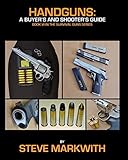
1 comment
Coincidentally, the little lady and I were looking at an EZ 9mm this weekend at a gun show. She did like it….a lot…. but I told her I wanted to hold off. I carry a Shield Plus and thought it best we buy an EZ Plus to give magazine compatibility. Only trouble was there were no EZ Pluses to be found. I really think that Smith has come a long way with this pistol. A real progression as to real improvements. They are to be commended for listening to the wants and needs of their customers.